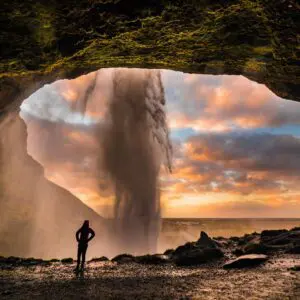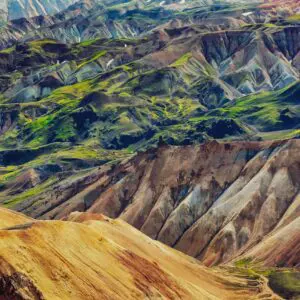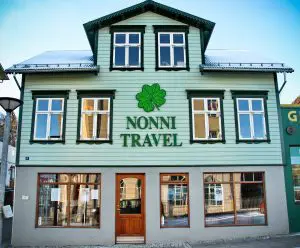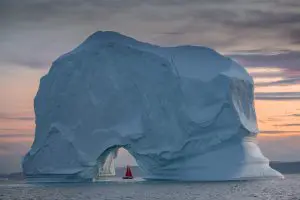Highlands of Iceland
Learn More About Tours in the Highlands of Iceland
 The Icelandic Highlands are unlike any other place in the country, and truly, anywhere in the world. Stretching across the island’s center, this vast region is home to black sand deserts, colorful rhyolite mountains, steaming geothermal fields, glacial rivers, and ancient lava flows. It’s no wonder the Highlands have long inspired folklore, adventure, and quiet awe.
The Icelandic Highlands are unlike any other place in the country, and truly, anywhere in the world. Stretching across the island’s center, this vast region is home to black sand deserts, colorful rhyolite mountains, steaming geothermal fields, glacial rivers, and ancient lava flows. It’s no wonder the Highlands have long inspired folklore, adventure, and quiet awe.
Tours in the Highlands offer a rare chance to enter this rugged, untouched landscape. Hiking through Landmannalaugar’s rainbow-colored hills, crossing the stark volcanic plains of Sprengisandur, or soaking in a remote natural hot spring, each moment feels like something out of another world. Many areas are only accessible during the summer months (from mid-June to early September), making the Highlands a seasonal gem for those willing to venture off the beaten path.
Due to the rough terrain and unpredictable weather, most Highland tours require a sturdy 4×4 vehicle and a knowledgeable guide or are part of a guided group where safety and local insight are combined.
Guides know these routes well, from hidden valleys to the best places to stop and take in the view. Tours are crafted not just for sightseeing but for truly experiencing the land: walking on ancient lava fields, hearing the silence between the mountains, and understanding the stories that live in the landscape.
Let us help you discover the Highland routes that locals treasure most!
From Our Backyard: Insider Tips, Culture & Adventure
A Local’s Guide to Car Insurance in Iceland: What Every Traveler Should Know
Velkomin!
Driving Iceland’s Ring Road: Everything You Need to Know Before You Go
Why Coolcations Are the Future of Travel: Iceland, the Faroe Islands, and Greenland Should Top Your List!
Most Common Questions About Tours in the Highlands of Iceland
What are the best tours in the Highlands of Iceland?
Top Highland tours include Landmannalaugar hiking tours, 4×4 Super Jeep adventures, guided treks in Þórsmörk and the Laugavegur, and explorations of the geothermal areas around Hveravellir.
Do I need a 4x4 vehicle to visit the Highlands?
Yes, a 4×4 vehicle is required to access the Highlands. Many roads are unpaved F-roads with river crossings, which are only suitable for high-clearance vehicles.
Can I visit the Highlands on a day tour from Reykjavík?
Yes, several day tours to the Highlands operate from Reykjavík, particularly to Landmannalaugar and Þórsmörk, often using Super Jeeps for safe and comfortable travel.
What should I wear on a Highland tour in Iceland?
Dress in layers with waterproof outerwear, sturdy hiking boots, a hat, gloves, and thermal gear. Weather in the Highlands can change rapidly, even in summer.
What kind of wildlife can I see in the Icelandic Highlands?
The Highlands are home to Arctic foxes, migrating birds, and hardy sheep roaming freely. Wildlife is less visible in coastal areas, but it is still present.
What makes the Highlands different from the rest of Iceland?
The Highlands are remote, uninhabited, and wild. Unlike coastal regions, they offer vast open landscapes, volcanic deserts, geothermal valleys, and a raw sense of isolation.
Should I book Highland tours in advance?
Yes, due to the short summer season and limited availability, it’s highly recommended to book Highland tours in advance, especially for guided hikes and multi-day trips.
When is the best time to visit the Highlands of Iceland?
The Highlands are usually accessible from mid-June to early September. This short summer window offers the best weather, open Highland roads (F-roads), and ideal hiking conditions.
Are there guided hiking tours in the Highlands of Iceland?
Absolutely. The Highlands are a hiker’s paradise, and guided hiking tours are available in Landmannalaugar, Þórsmörk, Kerlingarfjöll, and other iconic areas.
Are the Highlands of Iceland suitable for families?
Some Highland tours are family-friendly, especially shorter trips to hot springs or scenic stops. Always check age limits and activity levels before booking to ensure a suitable experience.
Are there natural hot springs in the Icelandic Highlands?
Yes, several Highland areas feature natural hot springs, including Landmannalaugar and Hveravellir. Many tours include stops where you can relax in geothermal hot springs or pools.
Are photography tours available in the Highlands of Iceland?
Yes, several specialized photography tours focus on capturing the surreal landscapes of the Highlands, including volcanic craters, rhyolite mountains, and remote vistas.
Can I combine Highland tours with other regions of Iceland?
Many multi-day tours combine Highland routes with other regions, such as the South Coast, Golden Circle, or the North of Iceland, for a well-rounded adventure.
Is it safe to drive in the Highlands of Iceland on your own?
While it’s possible, driving in the Highlands requires experience with river crossings, rough roads, and navigating remote areas. Guided tours are a safer option for most visitors.










